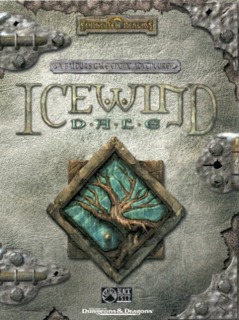Better than I thought......
The former owners of these bones are not refreshed He's ugly and doesn't deserve to live... Pool of Radiance and its sequels, as well as the Eye of the Beholder serial, distinguished their makers from SSI and Westwood and made them a certain standard in grading of other FRP games. Black Isle Studios is the next great name in this genre. Their Baldur's Gate, with its complexity and fidelity of almost all D&D rules, set new road marks for future games, while Planescape Torment proved that quality plots are still possible in the computer industry.
Their newest creation Icewind Dale will not revolutionize as their predecessors did, but it wont be in their shadow either. The release date has unfortunately overlapped with the release of Diablo II, so the success of this game is questioned with a reason, and because of the circumstances it wont draw the attention that a game of such quality deserves.
Icewind Dale is a Forgotten Realms world, created in the image of R.A. Salvatore books. It is a habitat of a large number of barbaric tribes that don't mind the snow and the severe Nordic climate, and don't mind calling this territory cut off from the rest of the world and surrounded by the mountain massive Spine of the World their home. The confusion is caused by Archmage Ericon --- hungry for power and thirsty for blood, with his army of mercenaries he took the advantage of the tribal feuds and started a campaign in the land if the ice. His plans were upset by shaman Jerodh, who united the barbaric tribes and defeated the evil archmage's army. In despair, Ericon opens the gateway to the dark dimension and nightmare creatures start pouring in. Jerodh thrusts himself bravely into the gateway, and blocks it with his life force. The gateway instantly turns into stone, but so does the brave shaman. That's when the player steps in with a group of his "apprentice" adventurers, who will through the prologue and the 6 chapters try to find the source of strange occurrences, such as the disappearance of tribesmen, harsh weather and the enormous activity of goblins and orcs. The story itself is ordinary, and the animation that leads you into it is not worth any particular mention. The thing that will intrigue you into playing the game is the superb voice of the narrator and the game soundtrack. The quality of both is such that they could easily be used in a motion picture on this subject.The programmers have decided that the game is to be engined by Bioware's Infinity engine. The result isn't bad, but it adds a kind of deja-vy sense, as well as the feeling that there is much to be desired. The long since outdated 640 x480 resolution, applied in Diablo II as well, looks surprisingly good even on larger monitors (the leap to 800x600 is promised in Baldur's Gate II). Some scenes are pre-rendered and well fitted and the water looks excellent. The characters are unfortunately done in 2D, but a little more detailed than in BG. The interface is almost identical to the ones in the predecessors and there is, of course, the option of pausing the action at any time in the game.As usual, the AD&D rules are followed to the letter. The whole system is so complex that a handbook is provided with the game to clarify certain terms, weapon list, item list and a list of available magic and spells in the game, and there are a lot of those (110 different spells for mages and about eighty for the priests). Anyone who wishes so, can study the charts by which you can calculate the strength of the strike, damage, race and class. The handbook is so extensive that can be used not only for the game, but also in FRP sessions.As opposed to BG you do not start the game as one character. You have the option of creating a team of six. It is up to you how many characters you will recruit, but the difficulty of the game and the number of conflicts suggests that you need a balanced group and a maximum number of team members. All the usual races and classes are present, and so is the usual assigning of aligning and the defining of characteristics by dice rolling. The option of picture insertion is preserved and you can change the .WAV with some of your own.The thing that bugged me the most is the linearity of the game. Beside the basic goal of the game - defeating the primordial evil, there are minor quests and their completion is not obligatory, but both one and the other are boiled down to "cleansing" a certain part of the map from hostile hordes of creatures with an occasional adventure task which is easy to achieve. This concept is well applied. The variety of hostiles, large number of magic items and the reward in the form of EXP. points is enough to keep you interested. Still, there is a lot lost in the replay value because the quests and the locations are changing always in the same fashion.

